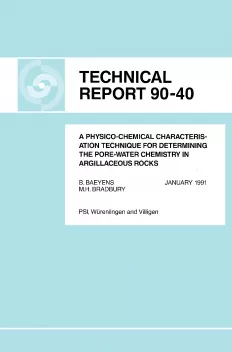
Technical Report NTB 90-40
A physico-chemical characterisation technique for determining the pore-water chemistry in argillaceous rocks
A prerequisite for carrying out credible sorption studies is the definition of an aqueous phase composition which is in equilibrium with the solid phase. Experimental methods and data analysis procedures are described which enable an equilibrium water composition to be produced for argillaceous rocks which is not dependent on liquid to solid (L:S) ratios. Since a Valanginian marl formation is under consideration by Nagra as a potential host rock for the disposal of low and short-lived intermediate level radioactive waste in Switzerland, samples of this material were chosen for this investigation.
Aqueous phase and nickel ethylenediamine extraction experiments were carried out at different L:S ratios under controlled atmosphere conditions (PCO2 = 10-2 bar, O2 ≤ 5 ppm). The results from these tests and petrographical examinations were combined to define the system in terms of the physico-chemical characteristics of the clay mineral component (CEC and cation occupancies) and the identities of highly soluble and solubility limited phases in the marl. The geochemical code PHREEQE was used in conjunction with the Gapon equations to calculate the pore water composition.
This work clearly showed that pore water chemistries obtained from aqueous extracts alone may lead to an arbitrary water chemistry in argillaceous rock systems, particularly with respect to ionic composition and ionic strength, which may have important consequences for radionuclide speciation and sorption studies.
